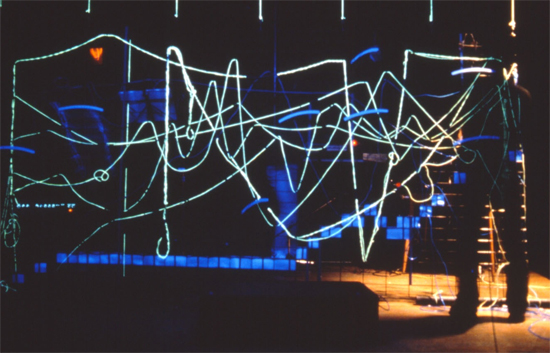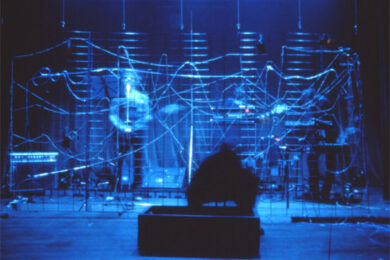When Richie Troughton wrote about his experiences of the Master Musicians of Joujouka on the Quietus a few months back, Wire bassist Graham Lewis was the first person to comment, writing how seeing them play was a "life-changing experience" that inspired his Kluba Cupol project. We thought we’d better get Richie to interview Lewis about the impact that they had on his life and work. Read on below…
Cupol, a collaboration between Wire bassist Graham Lewis and guitarist Bruce Gilbert with artist Russell Mills, saw the sounds of a rural village in north Africa re-imagined in an art-noise soundscape – the Like This For Ages EP. Cupol’s one and only recording had been a "musical homage" to the Master Musicians of Joujouka, inspired by their records.
And as luck would have it, the July 1980 release of the 12" on 4.a.d. was promptly followed by the opportunity for Graham to witness the Master Musicians of Joujouka (also spelt Jajouka) live for the first time, an experience he described as "life changing".
Graham saw all five-nights of the Moroccan ensemble’s landmark residency at Kensington’s Commonwealth Institute in September 1980. The epiphany of hearing the Musicians’ music is vividly described in the lyrics of the Cupol track ‘Like This For Ages’ – as if discovering a new world and outlook: "I salute the new day, It’s natural to be nervous… It’s been happening for ages", with the music a swarm of swampy dub bass, synths and clattering drums.
Thirty years on from Cupol, Graham remembers seeing the Joujouka Masters with affection: "There’s rarely a month goes by without me thinking about the experience, it’s just totally unforgettable."
Cupol would attempt to recreate their trance-inducing rhythms on the EP’s instrumental percussion-driven companion piece, the 20-minute b-side ‘Kluba Cupol’. Through a mutual friend, Lewis happened to know the person responsible for bringing the band out of North Africa and across Europe. "Rikki Stein had come across the group in the 60s," he recalls. "He had been on the trail to Morocco, discovered the Master Musicians and become completely obsessed. He was in total awe and felt other people should share his experience and good fortune."
The unusual spectacle made for an unusual crowd, intrigued by the mystique of the band attained in the 1960s following the visits of Rolling Stone Brian Jones, and Tangier residents William S Burroughs and Brion Gysin.
"The first night at the Commonwealth Institute was kind of a strange audience," remembers Lewis, who had himself encouraged all his friends to attend the party. "There were a lot of the good and the worthy kind-of-vaguely-interested-in something exotic, mixed with the Moroccan community who were there to let rip."
Not all were prepared for what was in store for them. "I think it was after the first number a middle-aged woman stood up and enquired [adopts shrill voice]: ‘Please, is it possible for you to adjust the volume? I’m finding it frightfully loud!’ This caused a certain amount of hilarity – Rikki walked out onto the stage and addressed the audience: ‘I know you can see the PA system, but it is not being used!’ The Master Musicians were simply acoustically LOUD!!
"They were just blowing people through the walls. The physical experience was magical. You couldn’t stay seated, I found it impossible. The rhaita players triangulated people who were sitting, took aim, played, and lifted them out of their seats! They were unable to remain seated… I experienced synesthesia; I saw a dome of harmonics. It was exciting and shocking!"

The effect of the volume raised by the Master Musicians was matched in intensity by the length of the pieces they were performing, made all the more remarkable by the age of some of the men. "The old man who played the bass drum must have been about 80," says Lewis. "And he ran the show. It was quite extraordinary to see an ensemble, which had what appeared to be an almost telepathic communication. It’s not something you see too often in Western music. Of course there are were exceptions like Sun Ra’s Arkestra, who were capable of playing for seven or eight hours, with a comparative kind of mastery and intensity, and that absolutely spellbinding shifting of rhythmic gears, making the music swerve in extraordinary ways. It’s a swinging acceleration that lifts you both, mentally and physically, again and again…
"Despite being previously aware of Joujouka, through the records which Ornette Coleman and Brian Jones had made with them, nothing prepared one for the actual manifestation of this 17-piece virtuoso Moroccan Maserati! What a ROAR!"
Around the time of the Joujouka concerts, the future of Wire was somewhat uncertain, the band having left EMI and members pursuing other projects. From their inception as novice musicians through to the creation of Pink Flag and beyond, Wire’s creativity and musicianship accelerated as they got used to their instruments. As guitarist Bruce Gilbert said: "We were moving so quickly that things came and went in the blink of an eye."
Having heard the Master Musicians’ records, Lewis and Gilbert once again had the creative spark to try out new sounds on the project that would become Cupol. The catalyst for the duo to start work on the music came after accepting a suggestion by then Wire manager Mike Collins to curate an event at Notre Dame Hall, Leicester Square. It also provided the opportunity to work with artist friend Russell Mills. He would "design a set that would also be a reactive and act as a musical score, which would involve a performer actually building the set as the music unfurled".
And with the Pipes of Pan ringing firmly in their ears, the pair set about creating the soundtrack. "When we had decided we were going to compose a piece for the evening," says Lewis. "I had recently bought a sound beat box… I started experimenting with it and rapidly understood that the actual preset sounds, were rather limited, but became much more interesting if you processed them through a line of guitar FX pedals. "I’d also bought a contact mike and with the application of a lump of blu-tack you could attach it to pretty much any object and produce a audio signal of some kind."
The length of the piece they were to make was dictated by the length of time they were expected to play that night, along with the length of the multi-track tape they were using – 20 minutes.
"We used the beat box to generate a rhythm as the basis to develop the piece," said Graham. In practice, the process of creating their homage was as much of a physical feat as anything else. Without the luxuries of sampling or sequencing, everything had to be recorded as a whole take.
"We attached the contact mike to a litter bin ashtray, donned a pair of gloves and proceeded to pound it on the floor, aiming for a 20 minute take, this became the bass drum… Russell played an Irish Bodhrán drum, we layered percussion, track upon track… After three days with this incessant rhythm, when you one retired to bed it was all you could hear. In our own small way we entered a form of rhythmic ecstatic state!"
Two or three years earlier a Wire song rarely broke the two minute barrier, and yet by this stage the musicians were putting out a piece that was 20 minutes long.
"The thing with Wire and the Pink Flag songs, is, as we have always said, they were that long because that’s how long they were," Lewis says. "We never really thought of them as being short. What we were trying to do was avoid what were the given and obvious templates for how you wrote a pop/rock song. And of course the brevity did rather frustrate the punks who wanted to pogo [laughs]. People were always being caught. Caught short, so to speak… pogo interruptus!"
The title ‘Kluba Cupol’ was inspired by current affairs. "It was an anagram of Kabul," explains Lewis. "The Russians were the next colonial power to make the mistake of trying to invade and govern Afghanistan." And having already established Dome, the name Cupol itself came from "cupola", the architectural theme followed into the cover, a painting of Bruce’s, inspired by Arabic mosaic.
Recording completed the EP was unveiled at the Notre Dame Hall concert, with a hand-picked line up of Blurt, D.A.F., and the premiere of the Quay Brothers’ debut short film Nocturnia Artificialia. Cupol’s performance featured an elaborate set constructed in front of them by young Japanese artist Shinro Ohtake, choreographed and created by Russell Mills.

Shinro had recently arrived in Britain to learn English and make contact with artists he admired. He recently became the first living artist to have a retrospective at the Museum of Modern Art in Tokyo.
The night collected not just an inspiring group of young creative talents, but also led to a number of future collaborations. After Cupol, Lewis and Gilbert continued to be productive under various guises, and from August 1980 (just a month after the Cupol disc) into 1981 they had released the first three Dome records. Continuing with dark minimal pieces, devoid of pop structure, and filled with warped atmospheric twists.
"I listened to the Cupol record yesterday," said Graham. "How on earth did we think that it was rhythmically tight or accurate!? But back in the day, our ideas about accuracy and rhythm were rather different!"
Thanks to Russell Mills for the Cupol live photos from 1980 at Notre Dame Hall and to the Master Musicians of Joujouka and Frank Rynne for the photo of current band leader Ahmed Attar, taken from the 1980 European tour booklet. Wire play The Lexington on behalf of the Quietus next Monday and Tuesday, November 8th and 9th



